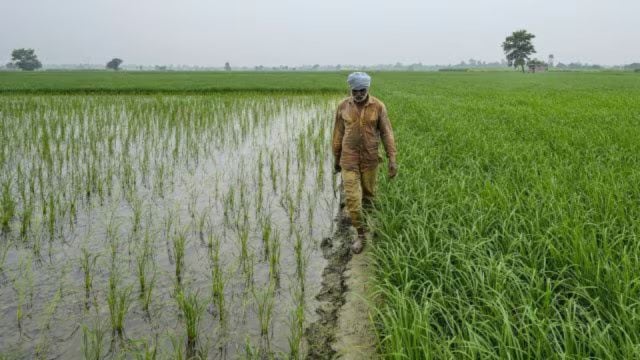Questions arise as Punjab crosses paddy procurement target despite lowest yield in a decade
In some cases, commission agents are believed to be helping traders pass off outside paddy from other states as Punjab-grown grain by linking it to local farmers’ names in mandi records.
 Despite the lower yield and reduced target, the state has already reached close to 157 lakh tonnes, raising concerns over the origin of the additional produce. (File Photo)
Despite the lower yield and reduced target, the state has already reached close to 157 lakh tonnes, raising concerns over the origin of the additional produce. (File Photo)Punjab has recorded its lowest paddy yield in nearly a decade, even as the state has surpassed its revised procurement target for the 2025–26 kharif season. According to the agriculture department, the average yield based on ongoing crop-cutting experiments (CCEs) stands at 5,669 kg per hectare, with 84 per cent of samples analysed so far—a figure that officials say is continuing to decline as more samples are processed.
The paradox of low yield, flood-hit acreage, and record procurement has triggered concerns within the government and agricultural circles over the possibility of large volumes of paddy from neighbouring states entering Punjab’s mandis and being sold at the minimum support price (MSP), camouflaged as local produce.
Punjab had reported 32.49 lakh hectares under paddy, including 6.83 lakh hectares under Basmati, which is not procured by government agencies. This brings the area under non-Basmati paddy to roughly 25.66 lakh hectares.
However, nearly 2 lakh hectares, growing mostly paddy in the low-lying bet areas, suffered crop damage during the August–September episodes of incessant rain and flooding. If this damaged acreage is subtracted, Punjab effectively had close to 23.63 lakh hectares under paddy this year. Applying the ongoing CCE yield of 5,669 kg per hectare, the state’s estimated procurement should have been close to 135 lakh tonnes. CCEs help in assessing the productivity of different crop varieties.
Yet, Punjab has already purchased close to 157 lakh tonnes of paddy till November 18—22 lakh tonnes above what the crop-cutting estimates suggest. Paddy arrivals, though now tapering off, are still being reported in small quantities in some parts of the state.
Punjab had set a procurement target of 185 lakh tonnes. But after the extensive crop damage caused by floods, false smut, dwarfing diseases, etc., the Government revised the target down to 150 lakh tonnes.
Despite the lower yield and reduced target, the state has already reached close to 157 lakh tonnes, raising concerns over the origin of the additional produce. Before this year, the lowest yield was recorded at 5,933 kg per hectare in 2015–16.
A senior Mandi Board official said the mismatch is “too large to be ignored,” adding,“If the crop-cutting yield is accepted as scientifically reliable—as it was last year—then the procurement exceeding estimated production by nearly 20 lakh tonnes is troubling. This gap cannot be explained without considering the possibility of paddy inflow from outside Punjab.”
Strong correlation between CCE yield and procurement
The concern arises because last year’s data had shown strong alignment between the CCE-based estimates and actual procurement. The area under paddy in 2024 was 32.43 lakh hectares, including the Basmati area of 6.80 lakh hectares, and the paddy (non-Basmati) area of 25.63 lakh hectares. The yield in the 2023 CCE was 6,670 kg per hectare, and the estimated production in 2024 was 171 lakh tonnes, while the actual procurement in 2023 was 174 lakh tonnes. This close match had reinforced confidence in the reliability of CCE-based calculations.
This year, however, the divergence is unusually wide—with procurement exceeding estimated production by nearly 2 million tonnes.
Farmer organisations and state officials say the sharp mismatch strengthens allegations that cheaper paddy from Rajasthan and other neighbouring states is being funnelled into Punjab’s mandis and sold at the MSP.
In some cases, commission agents (arhtiyas) are believed to be helping traders pass off outside paddy as Punjab-grown grain by linking it to local farmers’ names in mandi records. Such practices defraud the exchequer, distort production data, and undermine Punjab’s agricultural statistics, officials said.
Earlier, responding to the allegations, Vijay Kalra, president of the Federation of Arhtiya Association of Punjab, acknowledged that certain irregularities had come to light. “Only a handful of black sheep in our profession—those who are merely licence holders but not genuine arhtiyas—are indulging in these corrupt practices,” he said, adding that the actions of a few were harming the reputation of the entire community.
“With the procurement season nearing its close, the state now faces serious questions. How did Punjab procure 157 lakh tonnes of paddy despite the lowest yield in nearly 10 years? Why is there such a large gap between CCE-based production estimates and actual procurement? Has paddy from other states been entering Punjab mandis at a larger scale than previously acknowledged?” a senior officer in the agriculture department said.
“The agriculture department is expected to release the complete CCE dataset in the coming weeks. But there will be no major change in the current yield,” said another senior officer in the department.
Till November 17, around 11 lakh farmers benefited from the paddy MSP in the state, and more than Rs 36,000 crore has been paid to the farmers.
Food, Civil Supplies and Consumer Affairs Minister Lal Chand Kataruchak could not be contacted for comment on the mismatch in the yield and the procurement.







